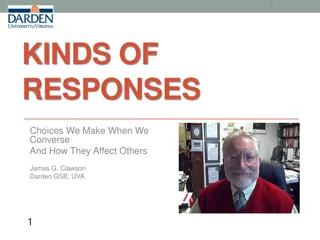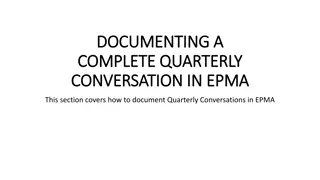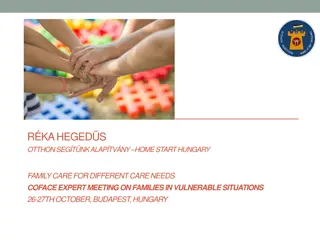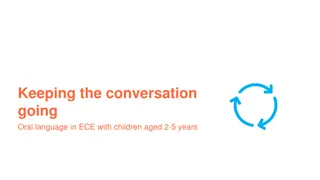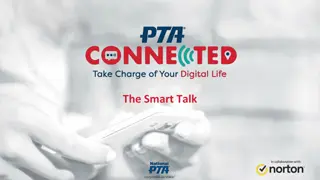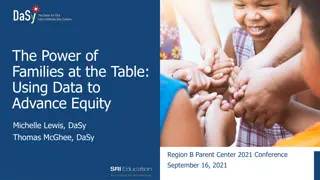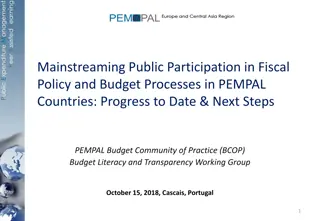Engaging Families in Data Conversations: Strategies for Effective Participation
Highlighting the importance of involving families in discussions about data at all system levels, this session aims to inform and engage families in conversations regarding local and state-level data. Strategies for sharing data with families will be shared and brainstormed, emphasizing the principles of effective stakeholder engagement.
Download Presentation

Please find below an Image/Link to download the presentation.
The content on the website is provided AS IS for your information and personal use only. It may not be sold, licensed, or shared on other websites without obtaining consent from the author.If you encounter any issues during the download, it is possible that the publisher has removed the file from their server.
You are allowed to download the files provided on this website for personal or commercial use, subject to the condition that they are used lawfully. All files are the property of their respective owners.
The content on the website is provided AS IS for your information and personal use only. It may not be sold, licensed, or shared on other websites without obtaining consent from the author.
E N D
Presentation Transcript
ENGAGING FAMILIES WITH DATA: HELPING FAMILIES PARTICIPATE IN CONVERSATIONS ABOUT DATA AT VARIOUS LEVELS WITHIN THE SYSTEM SIOBHAN COLGAN (DASY, IDC) SIOBHAN COLGAN (DASY, IDC) DARLA GUNDLER (DASY, EIFA) DARLA GUNDLER (DASY, EIFA) JUDY SWETT (ECTA) JUDY SWETT (ECTA) LISSETTE SAAVEDRA (ECTA) LISSETTE SAAVEDRA (ECTA) MELISSA RASPA (ECTA) MELISSA RASPA (ECTA)
PURPOSE OF THE SESSION Highlight the importance of family involvement in data discussions at all levels within the system Discuss ways to inform and engage families in conversations about local program and state level data Share and brainstorm strategies for sharing data with families
STAKEHOLDERS AND STAKEHOLDER ENGAGEMENT Who are stakeholders? o Can be internal or external to an organization/agency o Are affected by the outcomes of a project or initiative o Provide guidance on the progression of a defined scope of work o Examples include: families, ICC members, legislators, others? What is stakeholder engagement? o Using individual and group participation in a collaborative process that guides the creation and execution of a defined scope of work o A recurring and cyclical process
STAKEHOLDER ENGAGEMENT Why involve stakeholders? o Systems level impact o Creative problem solving o Satisfaction through collaboration o Improved outcomes
EFFECTIVE STAKEHOLDER ENGAGEMENT How to engage stakeholders, in particular families? o Relevance of information o Collaborative partnership o Effective communication o Shared ownership of problem-solving
PRINCIPLES OF EFFECTIVE STAKEHOLDER ENGAGEMENT Relevance of information o Define and articulate purpose of sharing data with families Why are we collecting and sharing data? o Specify and define desired outcomes What outcomes are the program/state hoping to achieve by sharing data with families? Collaborative partnerships o Create partnership with families How can we work together to achieve desired outcomes?
PRINCIPLES OF EFFECTIVE STAKEHOLDER ENGAGEMENT Effective communication o Establish consistent, responsive methods of communication When will we communicate with families about data? o Ensuring accessibility of information How will information be shared with families? Shared ownership o Build family capacity for involvement in discussions about data How will we help families understand data? How will we engage families in discussions about data?
DISCUSSION QUESTIONS How are you currently engaging families in discussions about data? Are families different than other types of stakeholders? When/at what levels should you ask for involvement from families? How do you share information (aka data) back with stakeholders? Is data presented to families differently than for others?
SHARING DATA WITH FAMILIES: EXAMPLES AND RESOURCES
SHARING DATA WITH FAMILIES What types of data can be shared with families? o Child and family outcomes data Program or State Level o General supervision data o Other APR indicator results and compliance data o Tools to help share data Calculators Graphics
STATE LEVEL CHILD OUTCOMES DATA Part C Early Intervention Part C Early Intervention National and State Percentages for Summary Statement 1: National and State Percentages for Summary Statement 1: Substantially Increased Rate of Growth, 2012 Substantially Increased Rate of Growth, 2012- -13 13 100 80 71 71 Percent of children 68 67 66 63 60 40 20 0 Social relationships Knowledge and skills National Actions to meet needs State Note: National data based on 41 states with highest-quality data Overall, our state data is fairly comparable Overall, our state data is fairly comparable to the national average for each of the 3 to the national average for each of the 3 child outcomes. child outcomes.
PROGRAM LEVEL FAMILY OUTCOMES DATA Know their rights Know their rights 100% 90% 80% 70% 60% 50% 40% 30% 20% 10% 0% 12 out of the 19 programs in our state are 12 out of the 19 programs in our state are above average on Indicator 1: Knowing above average on Indicator 1: Knowing your rights your rights
OTHER APR INDICATOR DATA 100% 90% 80% 70% 60% 50% 40% 30% 20% 10% 0% 2008-2009 2009-2010 2010-2011 2011-2012 2012-2013 IFSP in timely manner (C1) 45 day timeline (C7) Transition planning (C8) For the past 4 years, our state has made For the past 4 years, our state has made slight improvements or maintained high slight improvements or maintained high percentages for Indicators C1, C7, and percentages for Indicators C1, C7, and C8. C8.
STATE EXAMPLES North Carolina Early Intervention Program Annual Performance Report FFY 2012


